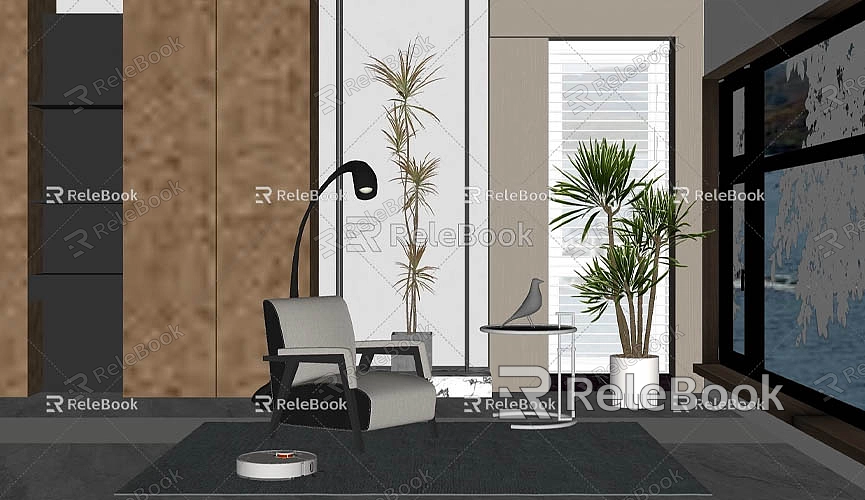How to Import a SketchUp Model into Rhino
In the fields of architectural design, industrial design, and 3D modeling, SketchUp and Rhino are two highly popular software programs, each with distinct advantages in specific application areas. SketchUp is beloved for its user-friendly interface and quick modeling capabilities, making it a favorite among architects, interior designers, and students. Rhino, on the other hand, is renowned for its powerful precise modeling tools and its ability to handle complex geometries, making it the go-to choice for many designers and engineers.
Despite their widespread use, these two software programs are not fully compatible in terms of file formats and workflows. SketchUp’s `.skp` file format cannot be directly read by Rhino, so importing a SketchUp model into Rhino requires additional steps and methods. By exporting the SketchUp model to an intermediate format, designers can smoothly import it into Rhino for further optimization, rendering, or processing.
This article will explore several common methods for importing SketchUp models into Rhino, discussing the pros and cons of each approach to help designers choose the best import method for their needs.

Why Import a SketchUp Model into Rhino?
Before diving into the steps, it’s important to understand why you might want to import a SketchUp model into Rhino. While SketchUp is unmatched in architectural design and spatial planning, it falls short in more precise modeling, complex surface design, and parametric modeling. Rhino excels in these areas. Therefore, importing SketchUp models into Rhino can offer several key advantages:
1. Precision Modeling and Control: Rhino handles complex geometric shapes, particularly freeform surfaces and intricate curves, with higher precision than SketchUp. If you need more detailed adjustments or advanced designs, Rhino is the better tool for the job.
2. Parametric Design: Rhino integrates with the powerful Grasshopper plugin, which provides parametric modeling capabilities. If you need to parametrize your SketchUp model or automate parts of the design process, Rhino offers significantly more flexibility.
3. High-Quality Rendering and Visualization: Rhino supports various high-quality rendering plugins (such as V-Ray, KeyShot, Rhino Render, etc.) that can enhance SketchUp models with more refined rendering results. If you need realistic rendering effects or more detailed lighting and material adjustments, Rhino provides a better platform.
4. Compatibility and Conversion: Rhino is compatible with other design tools like AutoCAD, 3ds Max, and Maya, making it easier to export SketchUp models and convert them into formats suitable for other professional software.
Import Methods and Steps
Since Rhino doesn’t directly support the `.skp` file format, you need to convert the SketchUp model into another universal 3D file format for import. Common methods include exporting to Collada (.dae), Wavefront (.obj), FBX, or 3DS file formats, and then using Rhino’s import function to bring the file into Rhino.
Using Collada (.dae) Format
Collada (.dae) is an open file format that supports multiple 3D software programs and is good for transferring geometric information, materials, and textures. Rhino handles Collada files well, so it is one of the preferred formats for importing models from SketchUp.

To export as Collada from SketchUp:
1. Use the "Export" feature in SketchUp to save the model as a `.dae` file.
2. Make sure to select options for exporting textures and materials to preserve the integrity of the model.
3. Once exported, open Rhino and select “File” > “Import,” then choose the Collada file type and open the `.dae` file. During the import process, Rhino will retain the basic geometry of the model, but you may need to tweak or reapply textures and materials.
Using Wavefront (.obj) Format
The `.obj` format is another common 3D file format widely used for data exchange between different modeling programs. Rhino supports the `.obj` format, which is suitable for importing mesh-based models. When exporting to `.obj`, more geometric information is typically retained, but textures and materials may need to be reapplied.
To export as `.obj` from SketchUp:
1. Choose “Export” > “Wavefront (.obj)” in the export menu.
2. Ensure that the options for including textures and materials are selected.
3. After exporting, in Rhino, go to “File” > “Import” and select the `.obj` file format. Rhino will import the model, but you may need to manually adjust texture mapping or reapply materials.
Using FBX Format
FBX is a format designed specifically for exchanging 3D animation and model data. It can store geometric data along with animations, materials, lighting, and other elements. If you have animations in your SketchUp model or need to transfer more scene data, the FBX format is a good option.
To export as FBX from SketchUp:
1. Select “Export” > “3D Model” and choose the FBX format.
2. During export, you can choose to export animations (if any) and other scene data.
3. After exporting, in Rhino, select “File” > “Import” and choose the FBX format for import. FBX will attempt to preserve the original data of the model, but since SketchUp and Rhino handle animations and complex scenes differently, some adjustments and optimizations may be required in Rhino.
Using 3DS Format
The 3DS format is an older but still widely used 3D model exchange format. It is particularly suitable for exporting simpler architectural models and mesh structures. When exporting a 3DS file from SketchUp, ensure that you select “Export” > “3D Model” and then choose the “3D Studio (.3ds)” format.
To export and import as 3DS:
1. In SketchUp, export the model as a `.3ds` file.
2. In Rhino, go to “File” > “Import” and select the “3D Studio (.3ds)” format.
3. Rhino will attempt to read the geometry, materials, and textures from the 3DS file. However, due to some limitations of the 3DS format, the model may lose some data, particularly in terms of complex materials and layer structures.
Using Rhino’s SketchUp Import Plugin
To simplify the import process, Rhino offers a dedicated SketchUp import plugin called Rhino for SketchUp. This plugin allows you to import SketchUp’s `.skp` files directly into Rhino, eliminating the need for format conversion. After installing the plugin, you can open `.skp` files directly through Rhino’s import function, and the plugin will automatically convert and import the model. This method is ideal for designers who frequently switch between SketchUp and Rhino, as it preserves the model’s geometry, layer structure, and material information.
Post-Import Adjustments and Optimization
While importing a SketchUp model into Rhino via different methods typically works well, the imported model often requires some adjustments and optimization. Here are some common post-import tasks:
1. Adjusting the Model’s Size and Scale
SketchUp and Rhino use different unit systems. SketchUp typically uses feet or meters, while Rhino uses "Blender units." As a result, the imported model may be scaled incorrectly. You can use Rhino's scale tool to adjust the model’s size and ensure it matches Rhino’s unit system.
2. Fixing Materials and Textures
Although Rhino can retain some basic materials and textures when importing from Collada, FBX, and other formats, the differences in the material systems of SketchUp and Rhino may cause textures to be misplaced or missing. You can use Rhino’s material editor to reapply textures or configure new materials within Rhino’s advanced material system.
3. Optimizing Meshes and Geometry
When importing complex SketchUp models, you may find that the model’s mesh is too detailed, which can affect Rhino’s performance. You can use Rhino’s "Simplify" tools (such as the Decimate Modifier) to reduce the polygon count or use Rhino’s repair tools to fix any mesh errors, improving modeling and rendering efficiency.
4. Cleaning Layers and Groups
Imported SketchUp models often contain multiple layers and groups that Rhino might not perfectly interpret. In this case, you’ll need to reorganize and clean up layers and groups to ensure the model structure is as expected in Rhino.
The process of importing a SketchUp model into Rhino can involve several steps, but by using intermediate formats like Collada (.dae), Wavefront (.obj), FBX, or 3DS, you can smoothly bring your SketchUp models into Rhino for further optimization, precise modeling, and rendering. Each file format has its advantages and limitations, so when selecting an export format, consider the complexity of your model, texture requirements, and intended use for the imported model.

